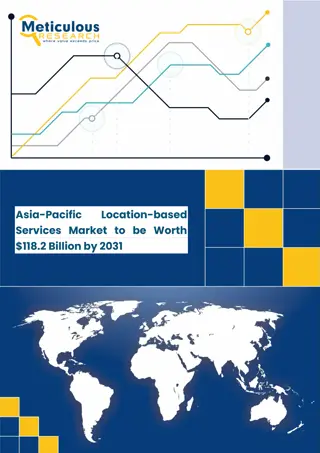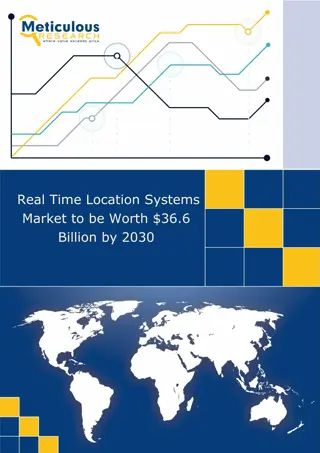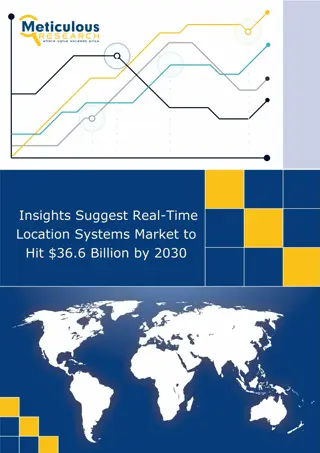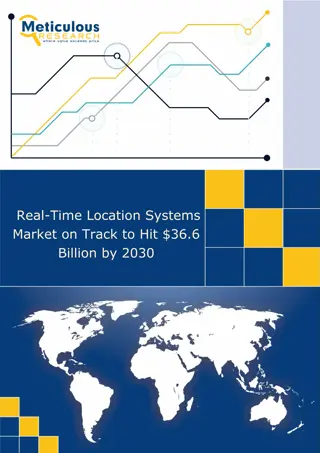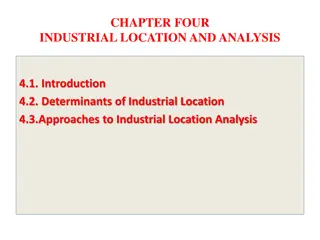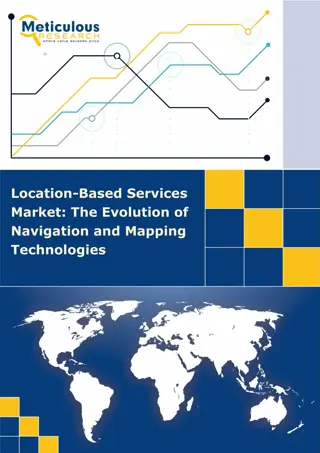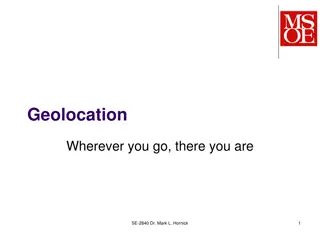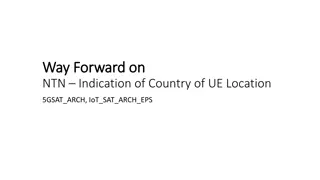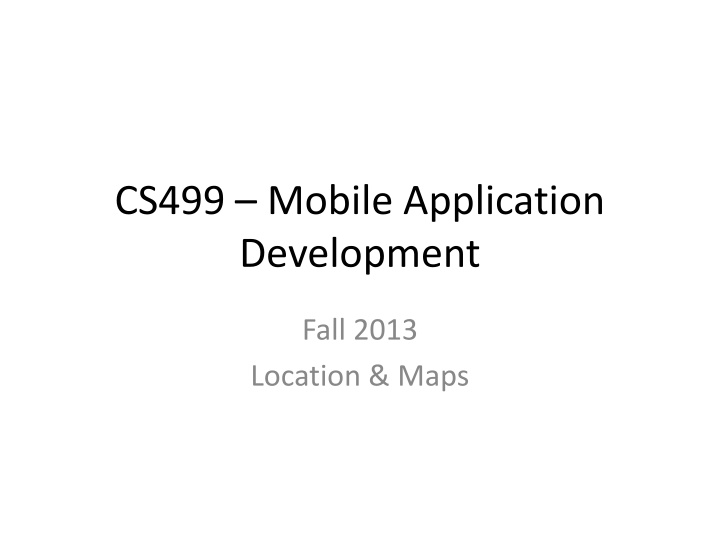
Location in Mobile Application Development
Understand the importance of location services in mobile applications and how locations are represented, provided, and managed. Explore different types of location providers and the functions of location manager and listener in obtaining accurate location data for enhanced user experience.
Download Presentation

Please find below an Image/Link to download the presentation.
The content on the website is provided AS IS for your information and personal use only. It may not be sold, licensed, or shared on other websites without obtaining consent from the author. If you encounter any issues during the download, it is possible that the publisher has removed the file from their server.
You are allowed to download the files provided on this website for personal or commercial use, subject to the condition that they are used lawfully. All files are the property of their respective owners.
The content on the website is provided AS IS for your information and personal use only. It may not be sold, licensed, or shared on other websites without obtaining consent from the author.
E N D
Presentation Transcript
CS499 Mobile Application Development Fall 2013 Location & Maps
Location Services Mobile applications can benefit from being location-aware, e.g., Routing from current to desired location Searching for store near location Android allows application to determine & manipuate location
Location Represents a position on Earth A location instance consists of: Latitude, longitude, a UTC timestamp Optionally, altitude, speed, bearing
LocationProvider Represents sources of location data Actual data may come from GPS satellites Cell phone towers Internet Different LocationProviders will exhibit different tradeoffs between cost, accuracy, availability & timeliness
LocationProvider Types Passive Returns locations generated by other providers Requires android.permission.ACCESS_FINE_LOCATION Network Determines location based on cell tower and WiFi access points Requires either android.permission.ACCESS_COARSE_LOCATION or android.permission.ACCESS_FINE_LOCATION GPS Determines location using satellites Requires android.permission.ACCESS_FINE_LOCATION
LocationManager System service for accessing location data getSystemService(Context.LOCATION_SERVICE) Enables Determining the last known user location Registering for location updates Registering to receive intents when the device nears a location
LocationListener Defines callback methods that are called when Location or LocatinProvider status changes void onLocationChanged(Location location) void onProviderDisabled(String provider) void onProviderEnabled(String provider) void onStatusChanged(String provider, int status, Bundle extras)
Obtaining Location Start listening for updates from location providers Maintain a current best estimate of location Stop listening for location updates Use best location estimate.
Location App public class LocationActivity extends Activity { private static final long TWO_MIN = 1000 * 60 * 2, MEASURE_TIME = 1000 * 30; private TextView mTextView = null; private Location mBestReading = null; private LocationManager mLocationManager = null; private LocationListener mLocationListener = null; onCreate(); @Override protected void onDestroy() { mLocationManager.removeUpdates(mLocationListener); super.onDestroy(); } private String getDisplayString(Location location) { return "Accuracy:" + location.getAccuracy() + " Long.:" + location.getLongitude() + " Lat.:" + location.getLatitude() + " Time:" + location.getTime(); } }
onCreate() @Override public void onCreate(Bundle savedInstanceState) { super.onCreate(savedInstanceState); setContentView(R.layout.main); mTextView = (TextView) findViewById(R.id.textView1); int mTextViewColor = mTextView.getCurrentTextColor(); // Location Listener (next slide) mLocationManager.requestLocationUpdates( LocationManager.NETWORK_PROVIDER, 0, 0, mLocationListener); mLocationManager.requestLocationUpdates(LocationManager.GPS _PROVIDER, 0, 0, mLocationListener); mLocationManager = (LocationManager) getSystemService(Context.LOCATION_SERVICE); mBestReading= mLocationManager .getLastKnownLocation(LocationManager.GPS_PROVIDER); if (null != mBestReading) { mBestReading.setAccuracy(Float.MAX_VALUE); if (System.currentTimeMillis() - mBestReading.getTime() > TWO_MIN) { mTextView.setTextColor(Color.RED); } mTextView.setText(getDisplayString(mBestReading)); mTextView.setTextColor(mTextViewColor); } else { mTextView.setText("No Initial Reading Available"); } Executors.newScheduledThreadPool(1).schedule(new Runnable() { public void run() { System.out.println("cancelled location updates"); mLocationManager.removeUpdates(mLocationListener); } }, MEASURE_TIME, TimeUnit.MILLISECONDS); }
mLocationListener = new LocationListener() { public synchronized void onLocationChanged(Location location) { if (null == mBestReading || mBestReading.getTime() - System.currentTimeMillis() > TWO_MIN || location.getAccuracy() < mBestReading.getAccuracy()) { mBestReading = location; mTextView.setText(getDisplayString(location)); } } public void onStatusChanged(String provider, int status, Bundle extras) {} public void onProviderEnabled(String provider) {} public void onProviderDisabled(String provider) {} };
Determining Best Location Several factors to consider: Measurement time Accuracy Provider type
Battery Saving Tips Location measurement drains the battery Return updates less frequently Restrict set of Location providers: Use least accurate (cheapest) provider possible Always check last known measurement Remove updates on onPause()
Maps Visual representation of area Going to use Google Maps library Note part of standard Android distribution Install SDK add-on build against add-on Google APIs (Google Inc.) Permissions: <uses-library android:name= com.google.android.maps /> <uses-permission android:name= android.permission.INTERNET />
Maps Classes MapActivity MapView GeoPoint Overlay ItemizedOverlay
MapView Extends ViewGroup Displays a Map in one of several modes: Street View photographs Satellite View aerial Traffic View real-time traffic superimposed Supports panning and zooming Supports overlay views Requires a Maps API key http://code.google.com/android/add-ons/google-apis/mapkey.html
MapActivity Base class for Activities that display MapViews Subclass creates MapView in onCreate() Only one MapActivity is allowed per process public class MapsEarthquakeMapActivity extends MapActivity public void onCreate(Bundle savedInstanceState) { super.onCreate(savedInstanceState); setContentView(R.layout.main); } protected boolean isRouteDisplayed() { return false; } } { <RelativeLayout ..."> <com.google.android.maps.MapView android:id="@+id/mapview android:layout_width="fill_parent android:layout_height="fill_parent" android:clickable="true android:apiKey= myMapsAPIkey /> </RelativeLayout>
GeoPoint Represents a location on Earth Latitude and longitude measured in microdegrees 1 microdegree == 1 millionth of a degree
Overlay Manages information drawn over a map e.g. points of interest within a given city MapView maintains a list of overlays Retrieve via MapView.getOverlays()
ItemizedOverlay subclass of Overlay Manages a list of OverlayItems OverlayItems have a particular locaiton Draws a drawable at OverlayItem s location Keeps track of a focused item



